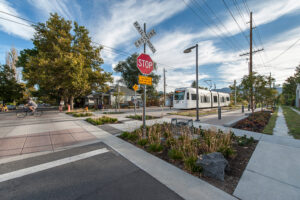How Transit-Oriented Development Can Transform Community Placemaking
March 2, 2023 by Nicole Masson
Policy/Legislative
How Transit-Oriented Development Can Transform Community Placemaking
By Kelly Gillman, ASLA, AICP
Three specific kinds of human activities contribute to a vibrant, engaging urban realm. Essential activities are part of everyday life: working, shopping, going to school. Voluntary activities are those that draw people to linger in a place: eating at a restaurant, sitting at a café, attending a game or other event. The third type of outdoor activity is intentional: people come to a place simply because they know that is where the people are. “Placemaking” is the art of creating a space where all three types of activities are happening simultaneously.
People are attracted to places where other people are, so there must first be a reason for people to be – and stay – in those places. Historically, a sense of “place” emerged naturally. Services were often grouped in the center of the community to accommodate pedestrian access. It made sense for key transit stations to also be located at the community center. Often other public spaces, retail markets, and religious destinations were found in proximity. The grouping of these services in one space tended to create a unique character and identifiable sense of place.
Today, we face new challenges in creating places with the same kind of character. Before the heavy use of automobiles, many places were built around a transit station. Today, communities are again turning to the transit station as one of many built components that can help create a sense of place. Once your community’s name shows up as a dot on a transit map, there is a greater opportunity to draw attention to residents, businesses, and visitors.
Thinking Beyond the Station
Today’s services are often distributed across a city, making it more challenging to establish the same sense of “place.” Despite changes in planning over the years, people still want to have places they can identify with. Communities still want a central square where people can gather. Transit stations, even local commuter stations with few amenities, can be a key component in the placemaking process.
However, simply adding a station to a community cannot by itself create a place. A place is made when there is a critical mass of amenities to support the gathering of people. Along the S-Line in Salt Lake City’s Sugar House neighborhood, simple streetcar stations have been constructed. They include shade structures, ticket vending, and informational signage. Enhancing the experience is the addition of a regional trail, enhanced landscaping along the corridor, and public plazas at key nodes. Based on feedback from the neighborhood before design began, the aggregated amenities along the S-Line together have established the place as a destination. The transit stations have prompted hundreds of millions of dollars in private development along the corridor, many interacting directly with the corridor’s open space.
How to Design a Standardized Transit Station to Fit a Neighborhood
The Utah Transit Authority has established a set of safety guidelines, station platform and shade structure design guidelines, as well as branding and signage guidelines for the bus, light rail, streetcar, and commuter rail transit systems. Working from the perspective of a transit operator, UTA seeks to provide a cohesive experience to their riders across the system. A patron on any of their services should be able to easily identify a transit station, understand how to use the services at that station, and safely interact with the system.
The creation of a unique place today often requires some creative thinking by community members. There may not be any historic fabric upon which to build your identity. The placemaking process in newly emerging places may require the development of a community brand, which may or may not be compatible with the brand of the transit system operator. Having worked in many communities, CRSA has seen first-hand the desire of municipalities to design custom transit stations, install unique pieces of art, and integrate station platforms into a more comprehensive urban development.
At the 650 South TRAX Light Rail System on Main Street in downtown Salt Lake City, three key design decisions were made to better integrate the station into the emerging community.
First, as a project partially funded by the RDA of Salt Lake City, public art was required. Salt Lake City selected a local artist, Jiyoun Lee-Lodge, who created a sculpture that fits the context of Salt Lake City.
Second, after some careful compromise with UTA, the design team collaborated with the owner of the adjacent office building to change the color of the UTA Station Shelter. The colors now match.
Third, despite a bevy of challenges in the construction of this station, a mid-block pedestrian crossing was installed to allow access to both ends of the center-running platform. Locally sourced and fabricated artwork, a holistic color palette (even if subtle), and connectivity are key characteristics that help to tie the transit station into the community.
The 650 South Main Street TRAX Station is unique in that it was the first in Utah to be constructed using a mix of public and private dollars. Understanding the importance of transportation to those living and working in the new neighborhood, developers worked with the RDA of Salt Lake City to construct a light rail station that had been envisioned 20 years prior. This balance of funding is happening with other stations, including the new Vineyard Station in Utah County. Vineyard City worked with state legislature to get funding to help catalyze private development.
It’s understood that having an adjacent station can help with the placemaking process and support the overall package of amenities found in a community. By continuing to introduce and prioritize public transportation infrastructure in our communities, we can bolster community character, support connectivity, and increase the capacity for growth.
Recent News
- » Planning In The News: Will Utah home prices drop as a result of the ‘silver tsunami’?
- » 2024 APA UT Spring Conference: Cedar City, UT. The Call For Sessions is Currently Open.
- » Planning in the news: Living in Daybreak- What residents say the Utah community is really like
- » Planning In The News: Planning Commission green lights proposed ban on gas stations near waterways and parks
- » As states argue over who should cut their Colorado River use, a new plan puts the environment first
- » Developer planned the demolition of the historic Fifth Ward meetinghouse
- » Long-awaited ‘River Tunnel’ at SLC Airport gets sneak peek




































